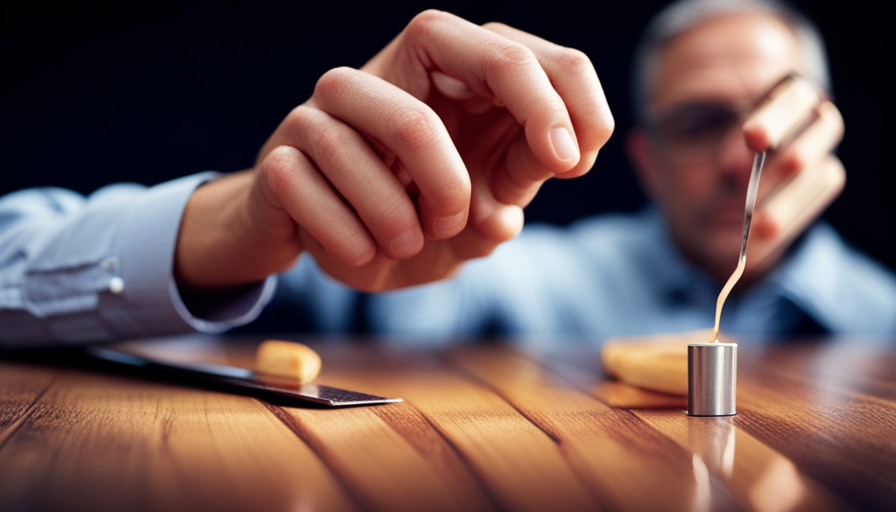Have you ever observed a flame as it dances gracefully, emanating a comforting heat that calms your spirit? It’s as if the flame holds a narrative within itself, a story of lasting grace and beauty. Within the realm of candles, one type shines for its eternal charm and mesmerizing appeal: the taper candle.
Like a delicate ballerina, the taper candle gracefully tapers from a wider base to a slender tip, symbolizing the journey of life itself. Its slender form, reminiscent of a flickering flame, evokes a sense of tranquility and serenity.
In this article, I will take you on a journey to discover the world of taper candles. We will delve into their rich history, explore their unique characteristics, and uncover their many uses.
Join me as we explore different types of taper candles, learn essential tips for burning them safely, and discover the beauty of taper candle holders and accessories. We will even explore DIY crafts and modern trends in taper candles.
Prepare to be enchanted by the timeless allure of taper candles, as we unravel the secrets of their captivating flame.
Key Takeaways
- Taper candles have a rich history in religious ceremonies and cultural celebrations.
- Taper candles offer versatility in size and color for any occasion or decor style.
- Taper candles can be used for various crafts and DIY projects.
- Taper candles create a cozy ambiance and are suitable for any decor style.
A Brief History of Taper Candles
Taper candles have a rich history that dates back centuries, with their slender, elegant shape symbolizing grace and sophistication. These candles have held significant cultural and religious symbolism throughout the years.
In ancient times, taper candles were used in religious ceremonies as a way to bring light into the darkness. The flickering flame was believed to represent the presence of a higher power and create a sacred ambiance. Taper candles were often lit during prayers, rituals, and special occasions, serving as a symbol of devotion and spirituality.
Beyond their religious significance, taper candles also played a vital role in cultural ceremonies and celebrations. For example, in medieval times, taper candles were used to illuminate grand feasts and banquets, adding an air of enchantment to the festivities. The soft glow of these candles created a warm and inviting atmosphere, enhancing the overall experience.
The unique characteristics of taper candles, such as their long, slender shape and steady burn, made them ideal for various purposes. Their elongated design allowed them to fit easily into candlesticks and candelabras, adding an extra touch of elegance to any setting. Additionally, their slow and controlled burn ensured that they would last throughout an event, making them a reliable choice for long-lasting illumination.
With their cultural significance and religious symbolism, taper candles have truly stood the test of time. Now, let’s explore the unique characteristics of these exquisite candles.
The Unique Characteristics of Taper Candles
Taper candles have several unique characteristics that make them a popular choice for many occasions. Firstly, their slender shape and narrow base allow them to fit easily into candle holders, creating an elegant and refined look.
Additionally, there are dripless and smokeless options available, making them ideal for indoor use without the worry of messy residue or unpleasant odors.
Lastly, taper candles come in a wide range of sizes and colors, providing endless possibilities for customization and adding a personal touch to any setting.
Slender Shape and Narrow Base
With its elegantly slender shape and narrow base, this type of candle creates a sophisticated and refined ambiance in any setting. The taper candle’s slender shape adds a touch of grace and elegance to any decor, making it a popular choice for formal occasions and special events.
Its narrow base allows it to fit easily into candleholders and candelabras, providing a secure and stable foundation for the flame. When lit, the taper candle emits a soft and flickering glow that adds warmth and intimacy to a room. It creates a romantic atmosphere, perfect for a candlelit dinner or a cozy evening at home.
The taper candle’s slender shape and narrow base make it easy to mix and match with other candles, creating beautiful arrangements and centerpieces. Additionally, its long and tapered design allows for a longer burn time, ensuring that the candle will last throughout the evening.
Moving on to the next section, dripless and smokeless options offer even more convenience and cleanliness.
Dripless and Smokeless Options
For those seeking a clean and hassle-free ambiance, there are options available that ensure a dripless and smokeless experience. Dripless candles are designed to minimize the mess and potential damage that can be caused by wax drippings. They’re made with a special blend of waxes and additives that allow the candle to burn evenly without producing excess liquid wax. This means you can enjoy the flickering flame and warm glow without worrying about wax spills.
Smokeless candles, on the other hand, are crafted using high-quality materials that produce minimal to no smoke when burned. This is especially beneficial for individuals with respiratory sensitivities or for those who simply prefer a cleaner burning candle. With dripless and smokeless options, you can create a tranquil atmosphere without the inconvenience of wax drips or smoke.
These candles are versatile in size and color, making them suitable for any occasion or decor style.
Versatile in Size and Color
Imagine the mesmerizing magic of a multitude of magnificently colored and perfectly proportioned candles, enhancing your decor and creating an enchanting ambiance.
Taper candles offer a wide range of size options, allowing you to choose the perfect fit for any occasion. Whether you’re looking for a petite candle to add a delicate touch to a small space, or a tall and elegant candle to make a grand statement, there is a taper candle size to meet your needs.
Additionally, taper candles come in a variety of colors, from classic white to vibrant hues, giving you the freedom to match your candles to your decor or create a stunning contrast.
So, let your imagination run wild with the endless possibilities of taper candle size and color options.
In the next section, we will explore the many uses of these versatile candles.
The Uses of Taper Candles
Lighting taper candles adds a touch of elegance and creates a warm ambiance, allowing you to immerse yourself in a moment of tranquility and reflection. Taper candles are not only versatile in size and color, but they also serve a variety of purposes.
One popular use for taper candles is as a centerpiece for special occasions or events. Placing taper candles in elegant taper candle holders can instantly elevate the overall look and feel of any table setting. Whether it’s a romantic dinner for two or a grand wedding reception, taper candles can help set the mood and create a mesmerizing atmosphere.
Taper candles can also be used for religious or spiritual practices. Many people light taper candles during prayer or meditation to enhance their spiritual connection and create a sacred space. The soft, flickering light of a taper candle can help calm the mind and promote a sense of inner peace.
In addition to their decorative and spiritual uses, taper candles can also serve practical purposes. For example, they can be used as emergency lighting during power outages or as a gentle source of light for a relaxing bath. Taper candles can also be used to add a touch of romance and intimacy to a room.
Transitioning into the next section about different types of taper candles, it’s important to understand the various options available to suit your specific needs and preferences.
Different Types of Taper Candles
Enhance your ambiance with a variety of taper candles that cater to your personal style and preferences. Taper candles come in different types, each offering a unique look and feel.
One popular type is the traditional tapered candle, which features a long, slender design that tapers towards the top. These candles fit perfectly into candle holders, adding an elegant touch to any setting.
Another type is the twisted taper candle, which has a spiral design that adds a modern and artistic flair to your decor.
If you’re looking for something more versatile, consider the dripless taper candle, which is designed to burn without creating messy drips. This type of candle is perfect for special occasions or for creating a clean and polished look in your home.
In addition to their aesthetic appeal, taper candles can also be used for various crafts. You can create your own unique candle holders by using different materials such as glass, metal, or even natural elements like driftwood. Taper candles can also be incorporated into centerpieces or used to add a touch of elegance to floral arrangements.
Now that you know about the different types of taper candles and their uses, let’s move on to some tips for burning them safely.
Tips for Burning Taper Candles Safely
To ensure your safety when burning taper candles, it’s important to keep them away from flammable materials and never leave them unattended while lit. For example, if you’re hosting a dinner party and have taper candles as part of your table centerpiece, make sure they are placed a safe distance away from any loose table linens or decorations that could potentially catch fire.
It’s also crucial to use a sturdy, heat-resistant candle holder that can securely hold the taper candle upright. This will prevent any accidental tipping or falling, which could lead to a fire hazard.
When lighting your taper candle, it’s recommended to use a long-reach lighter or a candle snuffer. This will keep your hand at a safe distance from the flame and minimize the risk of burns. Additionally, avoid placing the taper candle near drafts or air vents, as this can cause uneven burning and increase the chances of accidental fires.
Remember to trim the wick of your taper candle to about 1/4 inch before each use. This will help prevent excessive smoking and dripping, ensuring a cleaner and safer burn. Lastly, always extinguish the taper candle completely before leaving the room or going to bed. This will eliminate any risk of uncontrolled fires.
In the next section, we’ll discuss how to care for your taper candles to maximize their longevity and maintain their quality.
How to Care for Taper Candles
When it comes to caring for taper candles, there are three key points to keep in mind.
First, it’s important to regularly trim the wick to a quarter of an inch before each use to ensure a clean and even burn.
Second, store taper candles in a cool, dry place away from direct sunlight to prevent them from melting or warping.
Finally, to prevent wax drips, make sure to place the taper candles in a sturdy holder and avoid placing them near drafts or air vents.
Trimming the Wick
Trimming the wick of a taper candle ensures a clean and steady burn, creating a warm and inviting atmosphere. Proper wick maintenance is essential for maximizing the lifespan of your taper candles. To achieve the best results, follow this simple trimming technique:
- Trim the wick to ¼ inch before each use to prevent excessive smoke and soot.
- Use a sharp wick trimmer or scissors for a clean cut.
- Remove any debris or excess wax around the wick to promote an even burn.
By regularly trimming the wick, you’ll enjoy a longer-lasting and more efficient burn. It’s important to note that improper trimming can lead to uneven burning, dripping, or even extinguishing of the flame. Now that you know how to trim the wick, let’s move on to the next step – storing taper candles.
Storing Taper Candles
Make sure you store your taper candles in a cool, dry place to keep them in their best condition. Proper candle storage is essential for preserving taper candles.
When exposed to heat or moisture, the candles can become warped or discolored, affecting their overall appearance and burn time. To prevent this, find a storage location that is away from direct sunlight, as the UV rays can fade the color of the candles. Additionally, avoid storing them near any sources of heat or moisture, such as radiators or humidifiers.
It’s also a good idea to keep the candles in their original packaging or airtight containers to protect them from dust and debris. By following these storage guidelines, you can ensure that your taper candles stay in pristine condition and are ready to use whenever you need them.
Now, let’s move on to preventing wax drips.
Preventing Wax Drips
To avoid any messy wax drips, keep in mind that an ounce of prevention is worth a pound of cure. Here are three key tips to prevent wax spills and ensure a clean burning experience with your taper candles:
-
Choose the right taper candle size: Make sure to select taper candles that fit securely in your candle holders. If the candles are too thin or too thick, they’re more likely to drip wax.
-
Trim the wick: Before lighting your taper candles, trim the wick to about ¼ inch. This helps control the flame height and reduces the chances of excessive melting and dripping.
-
Use drip catchers: Consider using drip catchers or bobeches, which are small trays or cups that fit around the base of the candle. They catch any drips and protect your furniture or tablecloth from wax stains.
By following these tips, you can enjoy a drip-free and mess-free experience with your taper candles. Moving on to taper candle holders and accessories…
Taper Candle Holders and Accessories
When choosing taper candle holders and accessories, you’ll want to consider the style, material, and size that will best complement your taper candles.
Taper candle holders come in a variety of styles, from simple and classic to ornate and decorative. You can choose holders made from metal, glass, ceramic, or wood, depending on your personal preference and the overall aesthetic you want to achieve.
It’s important to select holders that are the right size for your taper candles, ensuring a secure fit that will prevent them from wobbling or falling over.
In addition to holders, there are also various accessories available for taper candles. Candle snuffers are a handy tool for extinguishing the flame without blowing wax everywhere, while drip catchers can help prevent wax drips from damaging your furniture or tablecloth.
You can also find decorative accessories like candle rings or decorative collars that can be placed around the base of the taper candle holders to add an extra touch of elegance.
With the right taper candle holders and accessories, you can create a stunning centerpiece or add a cozy ambiance to any room.
Now, let’s move on to the next section and explore some DIY taper candle crafts and decorations.
DIY Taper Candle Crafts and Decorations
Discovering if a theory holds true can captivate the audience and pique their interest when exploring DIY crafts and decorations with taper candles. There’s something satisfying about creating your own unique pieces using these elegant candles. Whether you’re a seasoned crafter or just starting out, there are endless possibilities for DIY taper candle crafts and decorations.
Here are a few ideas to get you inspired:
-
Dipped Taper Candles: Create a stunning ombre effect by dipping taper candles in different colored wax. Start with a light shade and gradually work your way to a darker hue for a visually striking display.
-
Taper Candle Centerpieces: Arrange taper candles of varying heights in a decorative holder or a vintage candelabra. Add some greenery, flowers, or seasonal elements to complete the centerpiece.
-
Taper Candle Wall Sconces: Mount taper candle holders on a wall to create an elegant and romantic ambiance. Arrange them in a symmetrical or asymmetrical pattern for a unique touch.
With these DIY taper candle crafts and decorations, you can add a touch of warmth and sophistication to any space.
Now, let’s transition into the subsequent section about the modern trends and innovations in taper candles.
Modern Trends and Innovations in Taper Candles
When it comes to DIY taper candle crafts and decorations, there are endless possibilities to explore. However, it’s also important to stay updated with the modern trends and innovations in taper candles. As a candle enthusiast, I have noticed a surge in the popularity of taper candles with modern designs and eco-friendly options.
One of the modern trends in taper candles is the use of unique shapes and patterns. Instead of the traditional straight and narrow design, taper candles now come in various shapes like twisted, spiral, and even geometric patterns. These designs add a contemporary touch to any space and make taper candles a focal point of decor.
Additionally, eco-friendly options have gained momentum in the taper candle industry. Many manufacturers now offer candles made from sustainable materials like soy or beeswax, which are not only better for the environment but also burn cleaner and longer. These eco-friendly taper candles have become a popular choice for those who want to enjoy the beauty of candles while minimizing their ecological footprint.
In the table below, you can see some examples of modern designs and eco-friendly options in taper candles:
| Modern Designs | Eco-Friendly Options |
|---|---|
| Twisted taper candles | Soy wax taper candles |
| Spiral taper candles | Beeswax taper candles |
| Geometric pattern taper candles | Recycled materials taper candles |
As we explore the modern trends and innovations in taper candles, it’s clear that there is a growing demand for both aesthetically pleasing designs and sustainable options. These advancements in the taper candle industry not only enhance our decor but also align with our values of environmental consciousness.
Transition: Moving forward, let’s delve into the timeless beauty of taper candles and their enduring appeal.
Conclusion: The Timeless Beauty of Taper Candles
To truly appreciate the enduring charm of taper candles, one must simply bask in their timeless beauty. These slender, elegant candles have been a staple in homes and events for centuries, and their decorative appeal never ceases to captivate.
Taper candles exude a sense of sophistication and grace, effortlessly enhancing any space they grace. The timeless beauty of taper candles lies in their simplicity. The slender shape and gradual tapering create an air of elegance that is unmatched by other candle options. When lit, the soft glow that emanates from the flame adds a touch of warmth and intimacy to any setting, making them perfect for romantic dinners or special occasions.
Beyond their visual appeal, taper candles also possess a practicality that adds to their allure. Their long burn time ensures that they will last throughout an evening, allowing for extended enjoyment. Additionally, their versatility allows them to be used in various candle holders and arrangements, making them a versatile choice for any decor style.
The timeless beauty of taper candles lies in their ability to evoke a sense of elegance and charm that transcends trends and time. Whether used as a centerpiece or to create a cozy ambiance, these candles never fail to add a touch of sophistication to any space. Their decorative appeal and enduring charm make them a classic choice that will continue to enchant for years to come.
Frequently Asked Questions
What are the standard dimensions of a taper candle?
The standard dimensions of a taper candle vary, but they typically range from 6 to 16 inches in length and have a diameter of around 7/8 of an inch at the base. These measurements ensure that taper candles fit securely in most candle holders.
Additionally, taper candles are commonly used for both indoor and outdoor settings due to their elegant design and ability to withstand slight wind.
Can taper candles be used outdoors?
Yes, taper candles can be used outdoors as long as they’re placed in outdoor taper candle holders. When selecting taper candles for outdoor use, it’s important to choose ones that are made from materials such as beeswax or soy wax, as they’re more resistant to melting in warmer temperatures. Additionally, make sure to keep the candles protected from wind to prevent them from flickering or going out.
Are taper candles safe to burn around children and pets?
Taper candles can pose a safety risk when burned around children and pets, as they can easily be knocked over and cause a fire hazard. To ensure safety, it’s important to choose non-toxic taper candles made from natural materials like beeswax or soy. Alternatively, LED taper candles provide a flameless option that eliminates the risk of burns or fires. Always supervise candle usage around children and pets, or consider using safer alternatives for their well-being.
How long does a taper candle typically burn for?
A taper candle typically burns for around 8-10 hours, depending on the quality of the candle. The burn time can vary based on factors such as the size of the candle and the conditions in which it is burned.
When it comes to candle quality, it’s important to choose candles made from high-quality materials that are designed to burn evenly and safely. This ensures a longer burn time and a more enjoyable experience.
Are there any eco-friendly options for taper candles?
There are indeed eco-friendly options available for taper candles. Instead of traditional wax, alternative materials like beeswax or soy wax can be used to create environmentally friendly taper candles. These options are renewable and biodegradable, making them a sustainable choice.
Additionally, DIY options are also a great way to create eco-friendly taper candles. By using natural ingredients and reusable materials, you can make your own taper candles that are both beautiful and environmentally conscious.
Conclusion
In conclusion, taper candles have a rich history and unique characteristics that make them a timeless beauty in the world of candlelight. Their slender shape and elegant design evoke a sense of grace and sophistication, like a ballerina gracefully pirouetting across a stage.
From their various uses to the different types available, taper candles offer endless possibilities for creating a warm and inviting atmosphere. So, whether you’re looking to add a touch of romance to a dinner table or create a cozy ambiance in your home, taper candles are the perfect choice.








